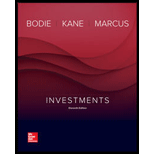
Investments
11th Edition
ISBN: 9781259277177
Author: Zvi Bodie Professor, Alex Kane, Alan J. Marcus Professor
Publisher: McGraw-Hill Education
expand_more
expand_more
format_list_bulleted
Concept explainers
Question
Chapter 8, Problem 5PS
A
Summary Introduction
To calculate: The number of estimates of variances, co-variances and expected returns that are required to optimize the given portfolio.
Introduction:
B
Summary Introduction
To calculate: The number of estimates needed, in order to, assumes in a safe manner that stock market returns are in close similarity with the single-index structure.
Introduction: Single Index model is a simple asset pricing model that measures both the risk and returns of any given stock.
Expert Solution & Answer
Want to see the full answer?
Check out a sample textbook solution
Students have asked these similar questions
What are some of the characteristics of a firm with a long operating cycle?
About this Assignment
For this Corporate Finance 301 assignment, you will submit a research paper that analyzes the types of organizational business
structures. You will apply knowledge of business structure concepts as acquired in the course. The research paper should follow APA
formatting style.
Project Prompts
The written research paper should be at least 1,000 to 1,200 words in length and should include four sections based on the business
structures studied throughout the course. Define each business structure, compare the corporate finance strategies of the four business
structures, discuss the advantages and disadvantages of each business structure, and how each varies in taxation.
Research Paper Sections
⚫ Sole Proprietorship
⚫ Partnership
• Corporation
⚫ Limited Liability Company (LLC)
PLEASE ANSWER THE COLUMN FULLY AND CORRECTLY
PLEASE DO THE RIGHT CALCULATION DOUBLE CHECK AS WELL TO GIVE ME THE RIGHT ANSWER
REQUIRED:
Given the following information, what are the NZD/SGD currency against currency bid-ask quotations?
Note: Do not round intermediate calculations. Round your answers to 4 decimal places.
Bank Quotations
American Terms
European Terms
Bid
Ask
Bid
Ask
New Zealand dollar
0.733
0.7340
1.3870
1.3884
Singapore dollar
0.6186
0.6191
1.6423
1.6436
answer
Bid
Ask
New Zealand dollar
?
?
Singapore dollar
?
?
Knowledge Booster
Learn more about
Need a deep-dive on the concept behind this application? Look no further. Learn more about this topic, finance and related others by exploring similar questions and additional content below.Similar questions
- About this Assignment For the Corporate Finance 301 assignment, you will submit a research paper that analyzes and discusses organizational financial risks. You will apply knowledge acquired in the course and use the concepts of multiple financial risks as the basis of research and analysis. The research paper should follow APA formatting style. Audience: upper-level business students. Project Prompt Write a 1,000-1,200-word analysis discussing financial risk concepts and assess the impact of the different financial risks on an organization. For this assignment, you will structure your assignment using four research paper sections associated with corporate risk management, as studied in the course. Base your research paper on the financial statements analyzed in Corporate Finance 301 assignment 2 and apply the knowledge acquired in the analysis. Define each financial risk, discuss the risk associated components, and evaluate the financial risks and how they affect the corporation's…arrow_forwardBobby Nelson, made deposits of $880 at the end of each year for 6 years. Interest is 6% compounded annually. What is the value of Bobby’s annuity at the end of 6 years?arrow_forward1. Find the future value if $1,250 is invested in Simple interest account paying 6.5%: a. for 5 years b. for 20 years 2. Find the future amount $ 35,000 is invested for 30 years at 4.25% compounded: a. annually b. Quarterly c. monthly d. weekly 3. How much should be put into an account today that pays 7.75% compounded monthly if you need $10,000 in 5 years. 4. Find the effective rate for: a. 5.75% compounded quarterly b. 6.25% compounded daily. 5. $50 is invested at the end of each month into an account paying 7.5% compounded monthly. How much will be in the account after 5 years?…arrow_forward
arrow_back_ios
SEE MORE QUESTIONS
arrow_forward_ios
Recommended textbooks for you
 EBK CONTEMPORARY FINANCIAL MANAGEMENTFinanceISBN:9781337514835Author:MOYERPublisher:CENGAGE LEARNING - CONSIGNMENT
EBK CONTEMPORARY FINANCIAL MANAGEMENTFinanceISBN:9781337514835Author:MOYERPublisher:CENGAGE LEARNING - CONSIGNMENT Intermediate Financial Management (MindTap Course...FinanceISBN:9781337395083Author:Eugene F. Brigham, Phillip R. DavesPublisher:Cengage Learning
Intermediate Financial Management (MindTap Course...FinanceISBN:9781337395083Author:Eugene F. Brigham, Phillip R. DavesPublisher:Cengage Learning

EBK CONTEMPORARY FINANCIAL MANAGEMENT
Finance
ISBN:9781337514835
Author:MOYER
Publisher:CENGAGE LEARNING - CONSIGNMENT


Intermediate Financial Management (MindTap Course...
Finance
ISBN:9781337395083
Author:Eugene F. Brigham, Phillip R. Daves
Publisher:Cengage Learning

Portfolio Management; Author: DevTechFinance;https://www.youtube.com/watch?v=Qmw15cG2Mv4;License: Standard YouTube License, CC-BY